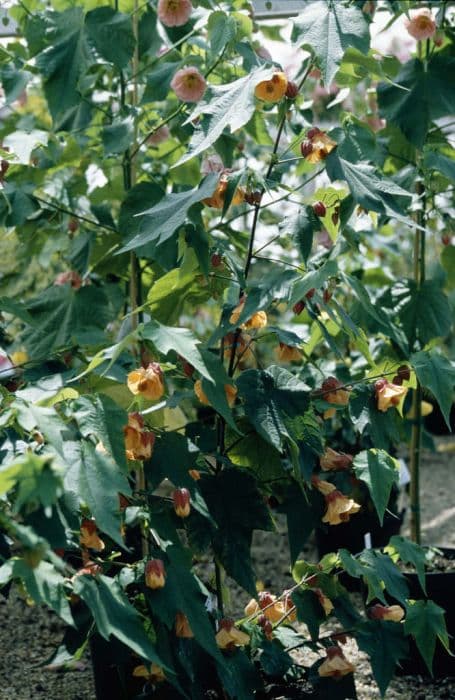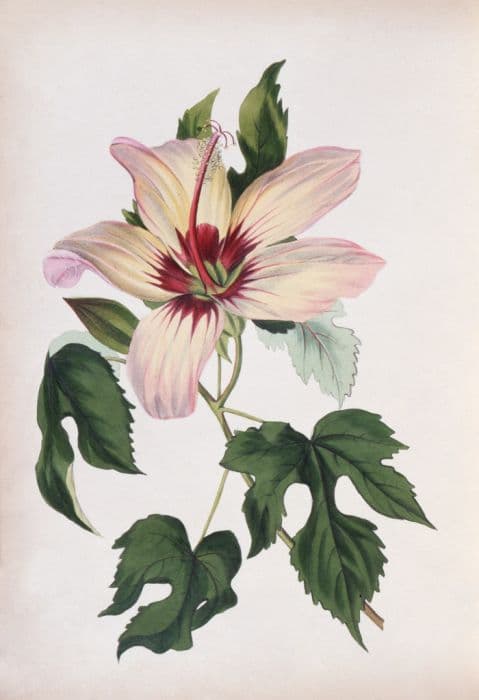Palm-leaf marshmallow Althaea cannabina






ABOUT
Althaea cannabina, commonly known as palm-leaf marshmallow, is a perennial herbaceous plant. It is characterized by its palmately lobed leaves, which are similar to those of the cannabis plant; hence, the species name "cannabina". The leaves are greyish-green and covered with a soft, velvety down. The palm-leaf marshmallow bears dainty, five-petaled flowers that are light pink to pale purple in color. These blooms typically cluster along the upper parts of the stems, creating a delicate, feathery effect as they sway in the breeze. Each flower has a darker center with prominent stamens. The stems of the plant are erect and branched, with a texture that is both tough and flexible. They are similarly covered in downy hairs that give them a soft, slightly fuzzy appearance. The overall shape of the plant is loose and airy, with its stems and leaves creating a fine-textured silhouette. Despite its common name, the palm-leaf marshmallow does not possess edible parts like the true marshmallow plant, which has roots historically used to create a treat that inspired today’s marshmallow confections. The plant's aesthetic qualities make it a pleasing addition to gardens, especially in naturalized or wildflower settings.
About this plant
 Names
NamesFamily
Malvaceae
Synonyms
Palm-Leaf Marshmallow, Hemp-leaved Hollyhock
Common names
Althaea kragujevacensis, Althaea taurinensis, Althaea wiedemannii.
 Toxicity
ToxicityTo humans
The plant known as Althaea cannabina, commonly referred to as Palm-leaf Marshmallow, does not have a well-documented profile of toxicity to humans. There are no commonly known toxic substances present in this plant that would be a cause for concern if ingested in typical amounts. Therefore, this plant is generally not considered poisonous to humans, and there are no specific symptoms associated with poisoning from Althaea cannabina commonly reported. However, as with any plant, individual allergies or reactions may occur, and it is always advisable to exercise caution and consult with a healthcare provider if any adverse effects are experienced after handling or ingesting any part of the plant.
To pets
Althaea cannabina, also known as Palm-leaf Marshmallow, is not widely recognized as a toxic plant to pets. There is limited information available on its effects if ingested by animals, and it is not listed among the plants that are commonly known to be poisonous to pets such as dogs or cats. Therefore, it is not typically associated with poisoning symptoms in pets. However, ingestion of any non-food plant material can potentially cause gastrointestinal upset, such as vomiting or diarrhea, in some pets. As with humans, some animals may experience individual sensitivities or allergic reactions. Pet owners should always monitor their pets for any signs of distress after ingesting plant material and consult with a veterinarian if they observe any adverse health effects.
 Characteristics
CharacteristicsLife cycle
Perennials
Foliage type
Deciduous
Color of leaves
Green
Flower color
Pink
Height
5-6 feet (1.5-1.8 meters)
Spread
2-3 feet (0.6-0.9 meters)
Plant type
Herb
Hardiness zones
7
Native area
Mediterranean
Benefits
 General Benefits
General Benefits- Ornamental Value: Althaea cannabina, commonly known as Palm-leaf marshmallow, is an attractive plant with dainty pink flowers and palmate leaves, making it a beautiful addition to ornamental gardens.
- Wildlife Attraction: The plant is known to attract bees, butterflies, and other beneficial insects, promoting biodiversity in the garden.
- Drought Tolerance: Once established, Palm-leaf marshmallow has good drought tolerance, making it suitable for xeriscaping and low-water gardens.
- Soil Improvement: The plant can help in soil improvement by adding organic matter through leaf and stem decay.
- Culinary Use: Certain parts of Palm-leaf marshmallow are edible and have been used in traditional cooking in its native regions.
- Fiber Production: The stems of Althaea cannabina have been used historically for fiber production, though this is not a common use today.
 Medical Properties
Medical Properties- This plant is not used for medical purposes.
 Air-purifying Qualities
Air-purifying QualitiesThis plant is not specifically known for air purifying qualities.
 Other Uses
Other Uses- As an ornamental plant: Althaea cannabina, commonly known as palm-leaf marshmallow, is often used in gardens for its attractive flowers and fine foliage, which can add a delicate texture to floral displays.
- In textile production: The fibrous stems of palm-leaf marshmallow have been historically used in textile production for creating woven fabrics.
- As livestock fodder: The leaves of the palm-leaf marshmallow can be used as fodder for livestock, particularly during times when other forage is scarce.
- In papermaking: The fibers from the stem of the palm-leaf marshmallow can be used in papermaking, contributing to a more sustainable source of paper pulp.
- As a natural dye: The flowers and other parts of the palm-leaf marshmallow contain pigments that can be used to produce natural dyes for coloring textiles.
- In basketry: The flexible stems of palm-leaf marshmallow can be harvested and woven into baskets and other craft items.
- As mulch: Dried leaves and stems of palm-leaf marshmallow can be used as mulch in gardens to retain soil moisture and suppress weeds.
- In composting: The plant material from palm-leaf marshmallow can be added to compost heaps to help enrich the soil with organic matter.
- As a cover crop: Planting palm-leaf marshmallow can protect the soil from erosion and help to improve soil structure and fertility as a green manure when tilled back into the ground.
- In pond filtration: When grown near ponds, palm-leaf marshmallow can contribute to natural filtration systems, helping to maintain water clarity and quality.
Interesting Facts
 Feng Shui
Feng ShuiThe Palm-leaved Marshmallow is not used in Feng Shui practice.
 Zodiac Sign Compitability
Zodiac Sign CompitabilityThe Palm-leaved Marshmallow is not used in astrology practice.
 Plant Symbolism
Plant Symbolism- Healing: Althaea cannabina is a relative of the marshmallow plant, which has been used for its medicinal properties to soothe and heal, symbolizing health and healing.
- Protection: Traditionally, plants from the Althaea genus were thought to have protective qualities, therefore representing safety and protection.
- Softness: With its velvety leaves, this plant symbolizes softness and comfort, much like the gentleness of its marshmallow relatives.
- Empathy: Like other healing herbs, Palm-leaf marshmallow might be seen as emblematic of empathy and caring, as it aids in soothing pain and discomfort.
 Water
WaterPalmate-leaf Marshmallow plants require consistent moisture, especially during their growing season in spring and summer. Water them thoroughly once the top inch of soil feels dry to the touch, which could mean watering every few days during hot periods or less during cooler, wetter periods. A good method is to use a watering can to gently soak the soil around the base of the plant, avoiding wetting the foliage, which can promote disease. On average, they may need about 1 to 1.5 gallons of water per week, depending on weather conditions and soil type.
 Light
LightPalmate-leaf Marshmallow thrives in full sun to partial shade locations. The plant prefers to be in a spot where it can enjoy at least six hours of direct sunlight daily, but it can also tolerate some afternoon shade, especially in hotter climates. Too little light can lead to leggy growth and fewer flowers.
 Temperature
TemperatureThe Palmate-leaf Marshmallow can withstand a wide range of temperatures but grows best when the temperature is between 60-85°F. It can survive minimum temperatures down to around 30 to 40°F but should be protected from hard frosts. In hot climates, it appreciates protection from the extreme afternoon heat.
 Pruning
PruningPruning Palmate-leaf Marshmallow helps maintain its shape, remove dead or diseased growth, and encourage bushier, more floriferous plants. Prune in late winter or early spring, cutting back the previous year's growth to healthy buds. Deadheading spent flowers can also promote further blooming.
 Cleaning
CleaningAs needed
 Soil
SoilThe best soil mix for the Palm-leaf Marshmallow (Althaea cannabina) is well-draining with plenty of organic matter, such as a blend of loam, peat, and sand. The soil pH should be neutral to slightly alkaline, around 6.0 to 7.5. Amend the soil with compost to enhance fertility.
 Repotting
RepottingPalm-leaf Marshmallow (Althaea cannabina) should be repotted every 2-3 years to replenish the soil and accommodate root growth. It's best to repot in the spring, just before the growing season begins.
 Humidity & Misting
Humidity & MistingPalm-leaf Marshmallow (Althaea cannabina) is tolerant to a range of humidity levels but thrives best in moderate humidity conditions. It does not require high humidity and can grow well in typical outdoor environments where the humidity is not excessively dry.
 Suitable locations
Suitable locationsIndoor
Ensure bright light and ample space.
Outdoor
Plant in sun, shelter from wind, enrich soil.
Hardiness zone
7-11 USDA
 Life cycle
Life cycleAlthaea cannabina, commonly known as Palm-leaf Marshmallow, begins its life cycle when seeds are sown in the soil and germinate, usually in spring. After germination, the seedlings grow into vegetative plants, establishing a rosette of leaves and then elongating with a stem that produces palmate-lobed leaves. As the plant matures, blooms appear in the summer, with small pinkish flowers that are attractive to pollinators. Following pollination, the flowers develop into seed pods that, once dry, release seeds to the environment. These seeds can remain dormant in the soil until conditions are favorable for the next cycle of germination. The plant is a perennial species and can regenerate from the rootstock if conditions are not suitable for seed germination.
 Propogation
PropogationPropogation time
Spring-early summer
The most popular method for propagating Althaea cannabina, commonly known as Palm-leaf marshmallow, is by seed. To propagate Palm-leaf marshmallow from seed, one should sow the seeds in late winter to early spring. The seeds need to be planted in well-drained soil at a depth of about 1/4 inch (approximately 6 millimeters) and spaced several inches apart to allow for proper growth. The soil should be kept moist but not waterlogged, and the seeds typically germinate in 21 to 28 days if kept at room temperature around 70°F (approximately 21°C). Once seedlings have developed and are strong enough, they can be transplanted to their final location outdoors after the risk of frost has passed.









